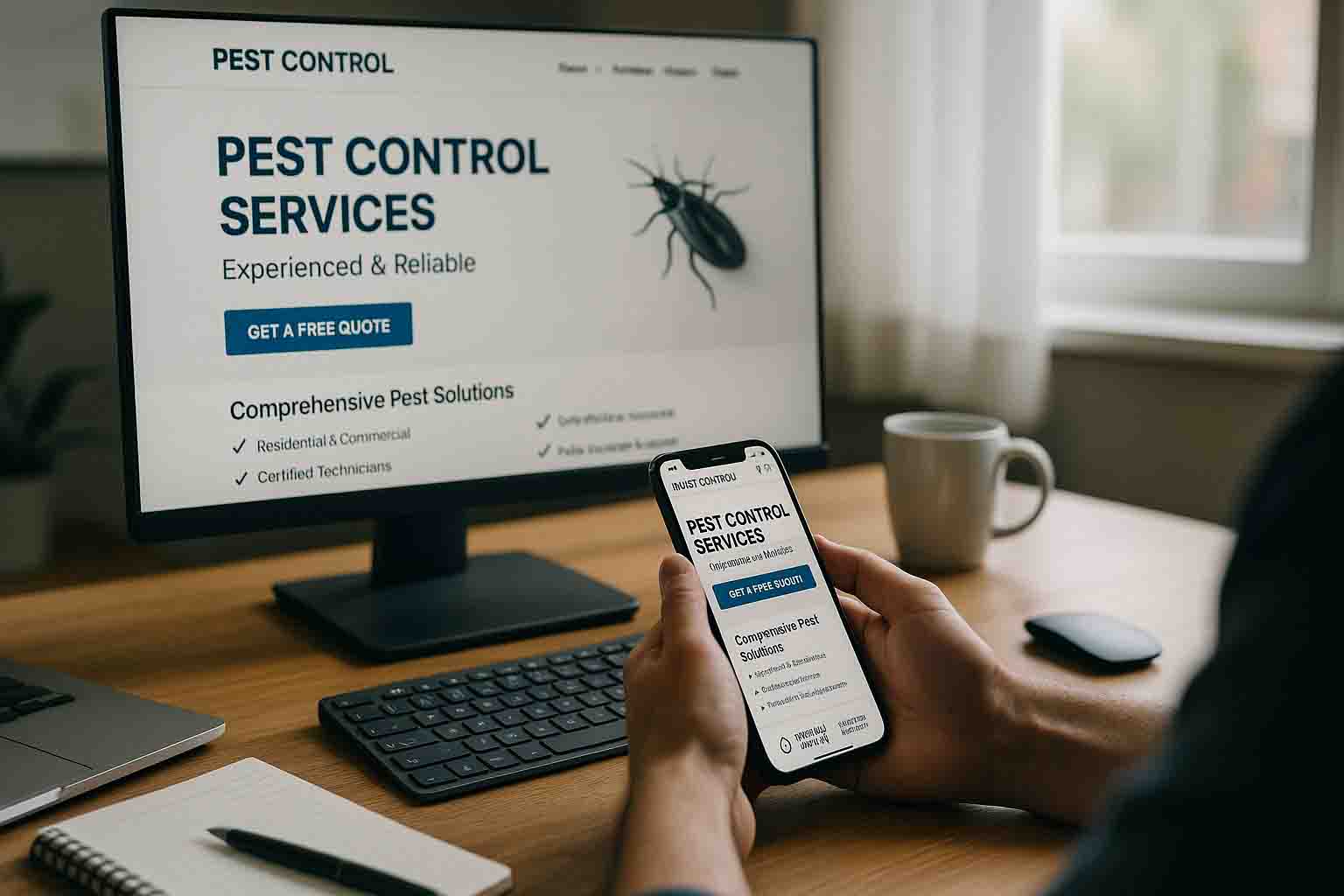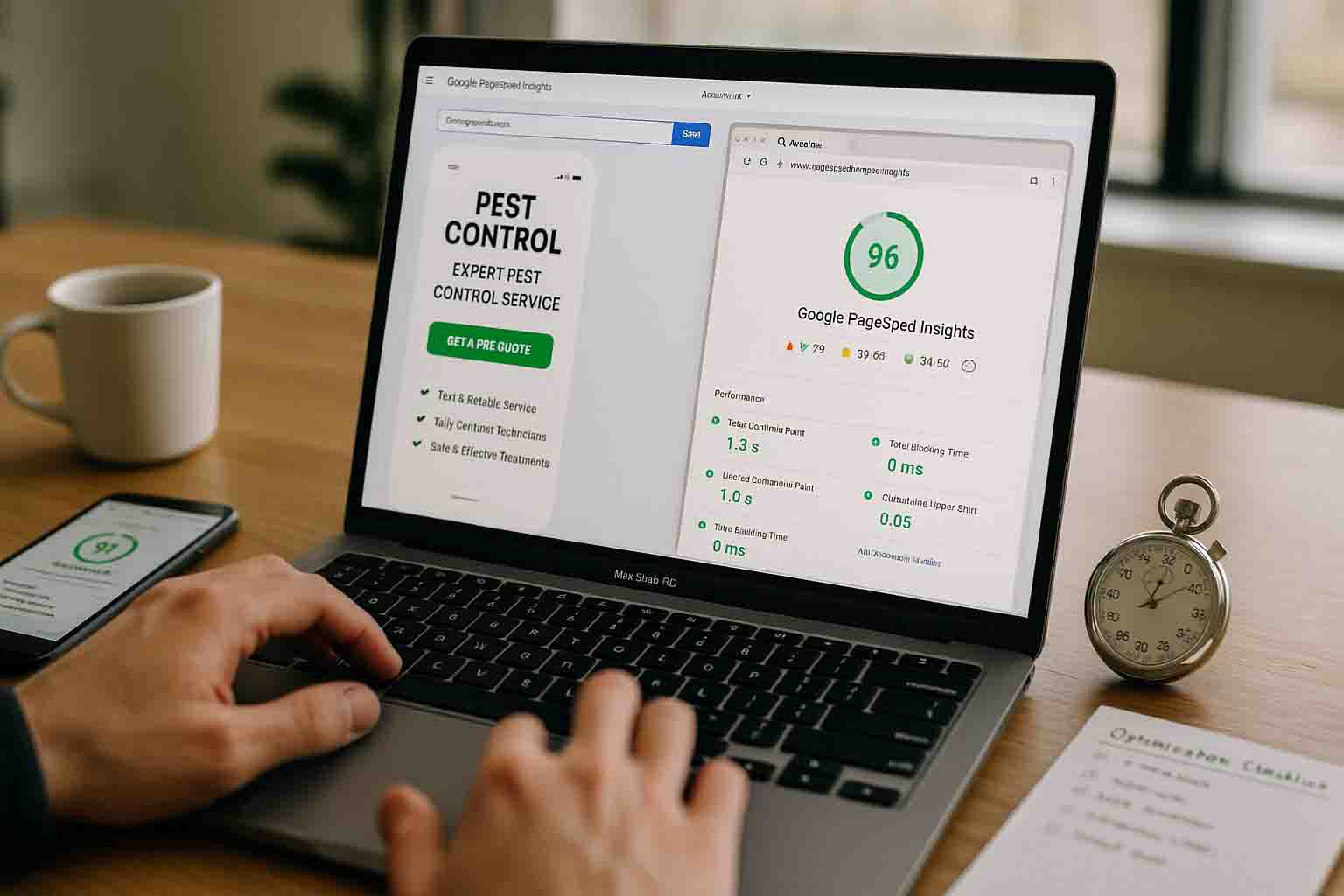Your Google Ad gets clicked. A potential customer searching "bed bug exterminator near me" lands on your website.
What page do they see?
If you're like most pest control companies, they land on your homepage. A generic page that talks about all your services, your company history, your commitment to excellence—everything except exactly what they searched for.
They hit the back button within 5 seconds. Your competitor's ad is right below yours. They click that instead.
You just paid $30-$50 for a click that went nowhere.
Here's the problem: Your homepage isn't designed to convert people searching for a specific service. It's designed to introduce your company to general visitors. Those are two completely different goals.
This is why landing pages exist—and why they convert 3-5x better than homepages for paid traffic and targeted organic searches.
This guide gives you the exact blueprint for creating pest control landing pages that turn visitors into calls, whether they're coming from Google Ads, Facebook Ads, or organic search.
What Makes a Landing Page Different From a Regular Website Page?
Let's clear this up first because there's confusion around what a "landing page" actually is.
A landing page is a standalone page built for ONE specific goal: conversion.
Homepage vs. Landing Page
Your Homepage:
- Purpose: Introduce your company to general visitors
- Audience: Anyone who finds your business
- Content: Overview of all services, company info, broad messaging
- Navigation: Full menu linking to every page on your site
- Goal: Educate visitors and direct them to relevant pages
Your Landing Page:
- Purpose: Convert visitors searching for a specific service
- Audience: People with a specific pest problem RIGHT NOW
- Content: Laser-focused on ONE pest/service and ONE call-to-action
- Navigation: Minimal (sometimes none)—don't give them a way to leave
- Goal: Get them to call or fill out a form
The key difference: A homepage is a hub. A landing page is a conversion tool.
When You Need Landing Pages (And When You Don't)
You NEED landing pages for:
✅ Google Ads campaigns - Each ad should send traffic to a relevant landing page, not your homepage
✅ Facebook Ads - Dedicated pages that match your ad messaging
✅ Specific pest problems - Bed bugs, termites, rodents each need their own conversion-focused page
✅ Seasonal campaigns - Mosquito season, rodent season, etc.
✅ Geographic targeting - Landing pages for specific cities/neighborhoods you're targeting
✅ Special offers - "$50 off first treatment" promos need dedicated pages
You DON'T need landing pages for:
❌ General company information (use your About page)
❌ Blog content (use blog post format)
❌ Company news or updates
❌ General browsing traffic (homepage is fine)
Bottom line: If you're paying for traffic (ads) or targeting a specific search query, you need a dedicated landing page.
The Anatomy of a High-Converting Pest Control Landing Page
Every high-converting landing page follows the same basic structure. Here's the blueprint.
Section 1: Hero Section (Above the Fold)
This is what visitors see in the first 3 seconds. Make it count.
What Goes Here:
1. Headline (Problem-Focused)
- Bad: "Professional Pest Control Services"
- Good: "Bed Bugs Keeping You Up at Night? We'll Eliminate Them in 24 Hours"
Your headline should:
- Acknowledge the specific problem they have
- Promise a solution
- Include timeline or outcome
2. Subheadline (Credibility + Benefit)
- "Licensed pest control experts serving [City] for 15+ years. Same-day service available."
3. Hero Image
- Your branded truck at a customer's home
- Your team in uniform
- Before/after (if not too graphic)
- NOT stock photos
4. Primary CTA Button
- "Call Now: [Phone Number]"
- "Get Your Free Inspection"
- Make it large, high-contrast color, impossible to miss
5. Trust Signal
- Review stars + count: "★★★★★ 4.9/5 (247 Google Reviews)"
- Years in business: "Serving [City] Since 2008"
- Certification badge
6. Phone Number
- Large, prominent, clickable on mobile
- Repeat it multiple times on the page
Section 2: The Problem (Agitate the Pain)
Help them understand the severity of their problem. This builds urgency.
What Goes Here:
Problem Description:
- What this pest is and why it's a serious issue
- Common signs they might have an infestation
- What happens if left untreated
Example (Bed Bugs):
"Bed bugs are more than just a nuisance—they're a health hazard and a nightmare that gets worse every day you wait. These blood-feeding insects hide in your mattress, furniture, and walls, coming out at night to feed on you and your family.
Signs you have bed bugs:
- Small red bite marks in clusters or lines on your skin
- Tiny dark spots on your sheets (bed bug fecal matter)
- Small reddish-brown bugs in mattress seams or furniture
- Musty, sweet odor in your bedroom
The problem gets worse fast. A few bed bugs can turn into hundreds within weeks. They spread from room to room. They're nearly impossible to eliminate without professional treatment."
Why This Works:
- Visitors self-identify ("Yes, I have those symptoms")
- Creates urgency (problem gets worse if ignored)
- Positions professional treatment as necessary (not optional)
Section 3: The Solution (Your Service Process)
Now that you've established the problem, present your solution.
What Goes Here:
Your Treatment Process (3-4 Steps):
Use a simple numbered or visual process:
Example:
- Free Inspection - We identify the extent of your infestation and entry points
- Customized Treatment Plan - We develop a treatment strategy specific to your home
- Professional Treatment - Our licensed technicians eliminate the infestation using proven methods
- Follow-Up & Guarantee - We ensure the problem is solved with follow-up visits included
Treatment Details:
- What methods you use (heat treatment, chemicals, integrated pest management)
- How long it takes
- What customers should expect
- Safety information (safe for kids/pets)
Your Advantage:
- What makes your approach different/better
- Why it works when DIY methods fail
- Certifications/training of your technicians
Section 4: Social Proof (Testimonials & Reviews)
People trust other customers more than they trust your marketing claims.
What Goes Here:
3-5 Specific Testimonials:
- Use real customer names (first name + last initial)
- Include their location (city/neighborhood)
- Focus on testimonials specific to THIS pest type
- Show results and experience
Example:
"We tried everything for our bed bug problem - sprays, powders, steaming. Nothing worked. [Company Name] came out the same day we called, did a heat treatment, and we haven't seen a single bed bug since. Worth every penny." - Sarah M., [Neighborhood]
Google Review Widget:
- Embed your actual Google reviews
- Shows real-time rating
- Adds credibility through volume
Before/After Photos (If Applicable):
- Termite damage → repaired
- Rodent entry points → sealed
- Keep it professional, not too graphic
Section 5: Why Choose Us (Differentiation)
What makes you different from the 20 other pest control companies in your area?
What Goes Here:
4-6 Key Differentiators:
✓ Same-Day Service Available - We respond fast when you need help now
✓ Licensed & Certified - [State License #], [Certifications]
✓ 15+ Years Experience - We've seen and solved every pest problem
✓ Family & Pet Safe - We use safe, effective treatment methods
✓ Satisfaction Guarantee - If pests return within [X] days, we retreat free
✓ Local Family Business - Not a national chain, we actually care
Why This Section Works:
- Addresses common objections before they arise
- Builds trust through credentials
- Creates urgency through availability ("same-day service")
- Reduces risk through guarantees
Section 6: Service Area & Availability
Make it crystal clear that you serve their location and can respond quickly.
What Goes Here:
Service Area Clarity:"We proudly serve [Primary City], [Suburb 1], [Suburb 2], [Suburb 3], and surrounding areas in [County] County."
Availability:
- "Same-day service available in most areas"
- "Emergency service available 24/7"
- "We respond within 2 hours of your call"
Call to Action:"Serving your neighborhood. Call now: [Phone Number]"
Section 7: FAQ (Answer Objections)
Address the questions preventing people from calling.
What Goes Here:
5-8 Questions Specific to This Pest:
For bed bugs:
- How much does bed bug treatment cost?
- How long does bed bug treatment take?
- Do I need to leave my home during treatment?
- How effective is your treatment?
- Are your treatments safe for kids and pets?
- What do I need to do to prepare?
- Do you offer a guarantee?
- How soon can you come out?
Keep answers:
- Short (2-4 sentences)
- Honest (if you need more info, say "We'll discuss this during your free inspection")
- Action-oriented (end with "Call us to discuss your specific situation")
Section 8: Final CTA (Last Chance to Convert)
One more opportunity to convert before they leave.
What Goes Here:
Strong Headline:"Ready to Solve Your [Pest] Problem? We're Here to Help."
Two CTA Options:
- Call Now - Large phone number, click-to-call on mobile
- Request Free Inspection - Short form (name, phone, email, address)
Urgency Element:
- "Limited same-day availability - call now to schedule"
- "Don't let the problem get worse - we can help today"
Trust Reminder:
- Review rating
- Years in business
- Guarantee
Landing Page Optimization Checklist
Before you publish your landing page, verify these elements:
✅ Messaging & Copy
- Headline addresses specific pest problem
- Benefits are clear (not just features)
- Pain points are acknowledged and agitated
- Solution is clearly explained
- Language is simple and direct (no jargon)
- Urgency is created without being pushy
✅ Calls-to-Action
- Multiple CTAs throughout page (minimum 3)
- Phone number is prominent and clickable on mobile
- CTA buttons use action words ("Call Now," "Get Free Quote")
- Primary CTA is above the fold
- Form is simple (name, phone, email max)
✅ Trust Elements
- Google review rating displayed
- Customer testimonials included (3-5)
- Certifications/licenses shown
- Years in business mentioned
- Guarantee or warranty stated
- Real photos (team, trucks, not stock images)
✅ Mobile Optimization
- Page loads in under 3 seconds on mobile
- Phone number is tap-to-call
- Buttons are large enough to tap easily
- Forms work smoothly on mobile
- Text is readable without zooming
- Images are optimized for mobile
✅ Technical SEO
- Page title includes target keyword + location
- Meta description is compelling and keyword-rich
- H1 headline includes target keyword
- Images have descriptive alt text
- URL is clean (e.g., /bed-bug-treatment-city-name)
- Page speed is optimized
✅ Conversion Tracking
- Google Analytics is installed
- Call tracking is set up (if using)
- Form submissions are being tracked
- Google Ads conversion tracking (if running ads)
Creating Landing Pages for Different Traffic Sources
Your landing page structure should adapt slightly based on where traffic is coming from.
Google Ads Landing Pages
Key Differences:
- Match your ad copy to landing page headline (message match)
- Minimal navigation (remove header menu if possible)
- Single, clear CTA
- Include ad keywords in headline and body copy
- Fast load time (impacts Quality Score and ad costs)
Example: If your ad says "Same-Day Bed Bug Treatment - Call Now," your landing page headline should say "Same-Day Bed Bug Treatment in [City]"
Facebook Ads Landing Pages
Key Differences:
- More education needed (cold traffic, not searching for you)
- Lead with emotional hook (fear, relief, urgency)
- More social proof (Facebook users trust peer reviews)
- Simple, mobile-first design
- Consider lead forms that stay on Facebook
Example:Facebook users weren't searching for pest control—your ad interrupted them. You need to capture attention fast with bold headlines and compelling visuals.
Organic Search Landing Pages
Key Differences:
- More detailed content (these visitors are researching)
- Include navigation (they may want to explore your site)
- Answer comprehensive questions
- Optimize for SEO (keywords, headers, content depth)
- Internal links to related services
Example:Someone searching "how to get rid of bed bugs" wants information first. Your page should educate, build trust, THEN ask for the call.
Landing Page Copy Formula (Fill in the Blanks)
Use this template to write your landing page copy for any pest:
Headline:"[Pest Name] [Causing This Problem]? We'll [Specific Outcome] in [Timeframe]"
Example: "Termites Eating Your Home? We'll Eliminate Them and Protect Your Investment in 48 Hours"
Subheadline:"[Credential/Experience] serving [Location] for [Years]. [Unique Benefit]."
Example: "Licensed termite specialists serving Austin for 18 years. Same-day inspections available."
Problem Section:"[Pest name] are [describe severity]. They [what they do]. Without professional treatment, [what happens if ignored]."
Solution Section:"Our [X]-step process eliminates [pest] completely:
- [Step 1]
- [Step 2]
- [Step 3]
- [Step 4]"
Social Proof: "Don't just take our word for it. Here's what [City] homeowners say about our [pest] treatment..."
CTA: "Ready to solve your [pest] problem? Call [phone number] or request your free inspection below."
Common Landing Page Mistakes to Avoid
❌ Mistake #1: Too Much Information
- Landing pages should be focused, not encyclopedic
- Cut anything that doesn't support the conversion goal
- Save detailed info for blog posts
❌ Mistake #2: Multiple CTAs (Competing Actions)
- Don't ask people to call AND fill out a form AND chat AND follow you on social media
- Pick ONE primary action (usually: call or form)
❌ Mistake #3: No Urgency
- Without urgency, people procrastinate
- Use: limited availability, problem getting worse, seasonal factors
❌ Mistake #4: Generic Messaging
- "Quality pest control services" doesn't convert
- Be specific about the pest, the problem, and your solution
❌ Mistake #5: Slow Load Times
- For paid traffic, every second of delay costs you money
- Optimize images, remove unnecessary scripts, use fast hosting
❌ Mistake #6: No Mobile Optimization
- 60-70% of your traffic is mobile
- Test on real devices, not just desktop
❌ Mistake #7: Weak Headline
- Your headline makes or breaks your conversion rate
- Test different headlines (A/B testing)
A/B Testing: How to Improve Your Landing Pages Over Time
Your first version won't be perfect. That's okay. A/B testing helps you improve over time.
What to Test (In Order of Impact):
- Headlines - Test problem-focused vs. benefit-focused
- CTA Button Text - Test "Call Now" vs. "Get Free Quote" vs. "Schedule Service"
- CTA Button Color - High-contrast colors usually win
- Hero Image - Test team photo vs. truck photo vs. before/after
- Form Length - Test 3 fields vs. 5 fields
- Social Proof Placement - Test reviews above vs. below the fold
How to A/B Test:
- Change ONE thing at a time (otherwise you won't know what made the difference)
- Run tests for at least 100-200 conversions (or 2-4 weeks minimum)
- Use tools like Google Optimize (free) or Unbounce/Instapage (paid)
- Track both calls and form fills (some changes help one but hurt the other)
Example Result:
- Original headline: "Professional Bed Bug Treatment"
- New headline: "Bed Bugs Gone in 24 Hours - Guaranteed"
- Result: 43% increase in conversion rate
Small changes can have massive impact.
Real Example: Bed Bug Landing Page That Converts at 12%
Let me show you what a high-performing landing page looks like in practice.
The Setup:
- Service: Bed bug treatment
- Traffic Source: Google Ads ("bed bug exterminator [city]")
- Average CPC: $38
- Monthly visitors: 150
- Conversion rate: 12%
- Monthly conversions: 18 calls
The Structure:
Hero Section:
- Headline: "Bed Bugs Keeping You Awake? We'll Eliminate Them in 24 Hours"
- Subheadline: "Licensed bed bug specialists. Same-day service. 100% satisfaction guaranteed."
- Large "Call Now" button with phone number
- 5-star Google rating (★★★★★ 4.9/5 - 189 Reviews)
Problem Section:
- Describes bed bug behavior, signs of infestation, health risks
- Creates urgency: "Every day you wait, the problem gets worse"
Solution Section:
- 3-step heat treatment process
- "Why heat treatment works when sprays fail"
- Treatment takes 6-8 hours, results are immediate
Social Proof:
- 3 testimonials specifically about bed bugs
- Before/after photos
- Google review widget
Why Choose Us:
- Same-day service available
- Heat treatment (chemical-free option)
- 60-day guarantee
- 12+ years specializing in bed bugs
FAQ:
- Cost, safety, preparation, timeline, guarantee
Final CTA:
- "Don't Spend Another Night With Bed Bugs. Call Now: [Phone Number]"
- Simple contact form (name, phone, address)
Why It Works:
- Hyper-focused on ONE problem (bed bugs)
- Clear, specific headline
- Urgency without being pushy
- Trust signals throughout
- Mobile-optimized
- Multiple CTAs
The Bottom Line: One Page, One Goal, One Action
Landing pages work because they eliminate distractions and focus on conversion.
The formula is simple:
- Address their specific problem
- Show you understand the urgency
- Explain your solution clearly
- Prove you're trustworthy (reviews, credentials, guarantees)
- Make it easy to take action (call or form)
- Repeat CTAs throughout the page
You don't need fancy design. You don't need complex copy. You need clarity, relevance, and a clear path to conversion.
Start with ONE landing page for your most profitable service. Test it. Improve it. Then create more.
Need Landing Pages That Actually Convert?
We've built dozens of high-converting landing pages for pest control companies. We know what works because we track every call, every form fill, and every dollar of ad spend.
Our landing pages include:
- Conversion-optimized structure based on proven principles
- Mobile-first design that loads in under 2 seconds
- A/B testing to continuously improve performance
- Integration with call tracking and analytics
We only work with one pest control company per metropolitan area.
Schedule a 15-minute discovery call to discuss your landing page needs.




